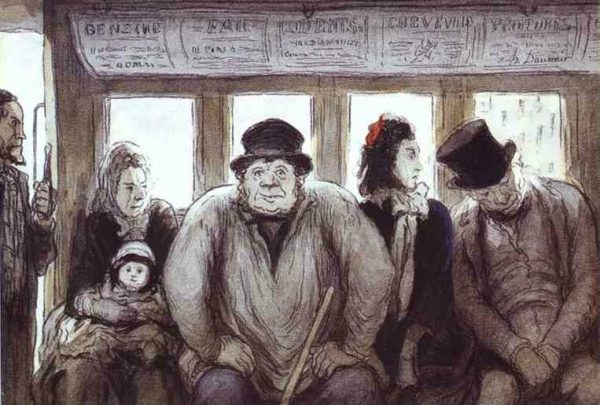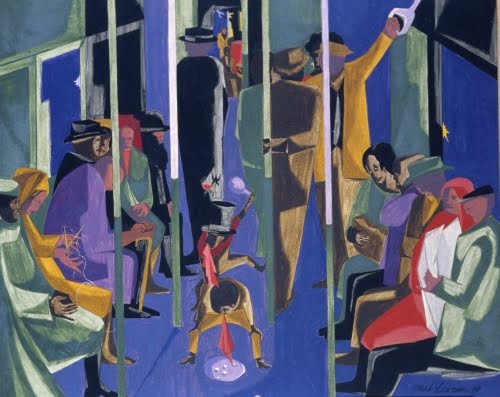Context
There is no venue for a “concentrated” experience of urban fellowship as the one provided by the system of public transportation that places everyone in the same wagon so to speak!
From Paris to London and New York and from Daumier’s famous sketch of early Paris omnibus riders characters, to Davidson’s photographs of the New York subway fauna, to Jacob Lawrence’s capture of children leap frogging in a subway train wagon … artists have had a field day expressing aspects of our common condition.
During the current period of mobility constrain, I was delighted to see how, by submitting to Google “The subway as subject for art,” I was provided with a wealth of examples of such art work.
These have allowed me to identify, illustrate and comment particular moments and situations of the underground subway experience: Entering the “mouth” of the subway, accessing its labyrinthian corridors in the anonymity of the crowd, waiting at the quay, loading and packing the wagons, being carried to destination, and finally exiting.
The Daumier omnibus characters

Daumier was a fabulous sketcher of the Paris social and political scene of mid 19th century and, given that matters of right to privacy, encumbering today’s work of the street photographer, did not yet exist, he had a field day at producing such documentation-cum-art work.
Dress and body language are used here to express gender and social status in almost portrait fashion.
Seated from left to right: the scarf covered baby carrying shop or house keeper working woman, the soft hat covered, stick carrying outsize porter, the ribbon in the hair and neck scarfed, somehow displeased “petit bourgeois” lady, and the dozing office worker, top hat covered and dressed in a crumpled three piece suit.
The underground experience
Entering

Being swallowed by the earth is not far from the particular feeling one experiences upon entering the subway system as directly as in the “hole in the sidewalk.” Of course the light posts, subway system map and graphic identification, and the occasional near by newspaper stand under a tree, will give that “hole in the sidewalk” a benevolent aspect: enter here all ye who want to get somewhere fast.
Accessing

Descending and advancing through tunnels, stairs and endless corridors do provide something of the labyrinth experience for the simple fact of lack of orienting context. The possible resulting panic may be relieved by previous knowledge of particular subway stations and/or by the usual directional graphics strategically posted along the way … when not courageous enough to ask for help to a fellow traveller.
The lonely crowd

The social-psychological aspect of the labyrinth experience is tied to the loss of one’s control over one’s movement, illustrated by the turnstile and iron bars handrails and screens, and here manifested by the particularly sad and tired expression of the travelers’ faces and body language.
Given the unusual crossing of multiple stairs and corridors, the absence of directional and identification graphics and the sterile surface color and eerie ambient light, we are not far from a human zoo of sort, or from a psychiatric ward experience of loss of identity and of situational fear.
Waiting

Beyond columns supporting the roof, beyond electrical boxes controlling energy distribution to lighting and other services and beyond the chasm where rails are laid and train circulate, we find a bench with three seated bag-carrying working stiffs: waiting.
We may ironically suppose that, at this Wall St. station, they represent the type of subway users for whom “time is not necessarily money”. The raw esthetic treatment of all architectural elements does not make a fit front for the New York financial district.
Loading

Piggy backing a bike on a subway train at the beat of a drum player, and followed by a flight of newspaper double pages, seems to indicate the relatively short amount of time the train awaits for all passengers to load its wagons, before closing its doors and moving on.
Packing

Full, but not packed front to back and shoulder to shoulder, this wagon carries workers of many trades going to their work places, and two generations of women, front and center, accompanying a young girl to school … perhaps newly arrived immigrants judging from their dress and head gear?
A very few women and persons of color in this morning train, that may be heading downtown, where pushing may come to shoving and good civic manner may give way to impatience.
Out of the great depression, at the beginnings of the New Deal, the way the riders read their morning paper seems to indicate a certain resignation or fatalism about the world situation that would eventually change the demographics of the subway riders, as women would take over the jobs of men gone to war.
Carrying

Leaving behind the social realism style proper to New Deal artists, and being exposed to modern movements coming from Europe, Lawrence will adopt a bright colorful palette in search of expressivity while keeping a narrative core.
In this painting children play at leapfrogging in the barely occupied central alley of the deep blue subway wagon. While facial expression are missing, the dress of the riders help distinguish gender and identity, in this case mothers watching children, suit wearing worker center rear and a variety of seated persons in colorful dress a mid distance.
The vertical holding poles, delimiting the central alley and delineating the sense of perspective, structure the painting, and the sense of movement of the wagon carrying its load of riders.
Exiting

Climbing out of the exit stairs, rushing away from the dull, bare bulb lit interior, toward the bright sunny outdoors reflecting on her face, the central character in the painting seems to be in a hurry to reach her destination … may be taking her son to school … may be rushing for a breath of fresh air !
The cubist rendering of the painting, and the use of jarring shapes and primary colors, contribute to the sense of dynamic movement.
Personal Note
A work of art, being the visual representation of a point of view on reality, will make it difficult, to a degree, to recognize the nature of that reality. A photograph, being a one to one graphic representation of reality, offers no less a point of view on it.
Beside the winter circumstances having placed a constrain on my mobility, the permission to take photographs in Montreal’s subway is a delicate thing to obtain, that needs planning and advance notification, and that is usually reserved for academic pursuit, film making, etc. Hence my relying on published art work.
My choice of the art works was based on their near documentary value, with a few exceptions such as the ones dealing with particular states of mind: labyrinthine disorientation, loneliness in the anonymous crowd and the sense of urgency or exhilaration at the moment of exit at street level.
Most importantly I wish to acknowledge the subtle dialogue that I found myself engaged in with the art works in order to articulate significant elements of the “underground experience” I have tried to put forth to the reader.
Art work Credit: as identified in captions, per Google images.
[alert type=alert-white ]Please consider making a tax-deductible donation now so we can keep publishing strong creative voices.[/alert]
